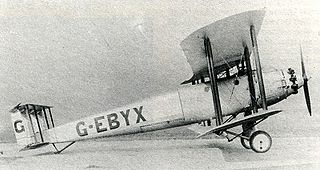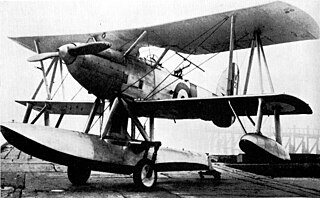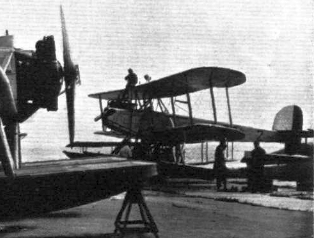
The Arado Ar 64 was a single-seat biplane fighter designed and produced by the German aircraft manufacturer Arado. It was among the first fighters produced when Germany abandoned the restrictions of the Treaty of Versailles and began rearming.
Luft-Fahrzeug-Gesellschaft, also referred to as LFG, was a German aircraft manufacturer during World War I. They are best known for their various "Roland" designs, notably the Roland C.II Walfisch (whale), Roland D.II haifisch (Shark) and Roland D.VI, although they also produced a number of airships and many experimental designs.

The BMW IV was a six-cylinder, water-cooled inline aircraft engine built in Germany in the 1920s. Power was in the 180 kW (250 hp) range.

The Albatros L 73 was a German twin-engined biplane airliner of the 1920s. Of conventional configuration, it featured a streamlined, boat-like fuselage and engine nacelles. All four manufactured aircraft of that type were operated by Deutsche Luft Hansa, one of which crashed near Babekuhl on 28 May 1928.

The Caproni Ca.97 was a civil utility aircraft produced in Italy in the late 1920s and early 1930s. As originally designed, it was a high-wing braced trimotor monoplane of conventional configuration with one engine mounted on the nose and the other two carried on strut-mounted nacelles at the fuselage sides. Examples were also produced with only the nose engine or only the two nacelle-mounted engines.

The Short Crusader also called the Short-Bristow Crusader and Short-Bristol Crusader was a British racing seaplane of the 1920s, built by Short Brothers to compete in the 1927 Schneider Trophy race.

The Gloster Goring was a single-engined two-seat biplane designed to meet 1926 Air Ministry specifications for a day/torpedo bomber. It was not put into production and the one aircraft built served later as an engine testbed.

The Bristol Seely was entered into an Air Ministry competition for safe civil aeroplanes held in 1920. It was a single-engine biplane with accommodation for one passenger. After the competition, the single Seely was used as a testbed for the Bristol Jupiter engine development programme.

The Vickers Vellore was a large biplane designed as a freight and mail carrier, in single-engined and twin-engined versions, which saw limited use as freighters and long-range experimental aircraft. A final variant with a broader fuselage, the Vellox, was completed as an airliner.

The Short S.7 Mussel was a single-engined two-seat monoplane built by Short Brothers to test the performance of their duralumin monocoque floats. Two were built.

The Short Gurnard was a single-engined two-seat biplane naval fighter, built in the United Kingdom to an Air Ministry specification in 1929. It failed to win production orders and only two flew.

The Junkers T 19, originally known as the J 19, was a single-engined parasol winged all-metal 2/3-seat aircraft built in Germany in the early 1920s for training and touring. Its construction was too expensive for commercial success and only three were built, one later finding use as an engine test-bed.

The Pander E was the first indigenous Dutch training aircraft, used by clubs and also privately owned. A two-seat, single-engine biplane, 17 were built in the Netherlands from 1926 with engines of increasing power.

The LFG Roland D.XVII was a single-seat, single-engine, parasol wing German fighter aircraft flown close to the end of World War I. Only one was built.

The LFG V 40 and V 44 were one-off, single-engine, two-seat sports monoplanes, identical apart from their engines, built in Germany in 1925.
The V 42 was a one off, single-engine, two-seat sports monoplane, built in Germany in 1925.

The LFG Roland Pfeilflieger, (Arrow-flyer), was a German swept wing, single engine, two seat biplane built in Germany in 1914. It made one distinguished long duration flight and served in colonial German South-West Africa.

The LFG V 60 was a small, single engine, tandem seat floatplane training aircraft, designed and built in Germany in the mid-1920s. About five were constructed.

The Rohrbach Ro VII Robbe was an all-metal, twin engine flying boat built in Germany in the 1920s. It could be adapted to commercial or military rôles.

The Kawanishi K-6 was a passenger-carrying biplane floatplane, built in Japan in the 1920s. The sole example took part in an around Japan flight then flew as a transport with Japan Aviation.



















